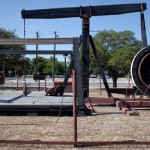What’s Leaking from the BP Refinery in Texas City?

William Philpott/AFP
Workers sift through debris at the BP facility in Texas City 55 kilometers (35 miles) south of Houston, 24 March 2005, after an explosion that killed 15.
Earlier this week there were reports of a leak at the BP refinery in Texas City, Texas, just outside of Galveston. Sulfur dioxide (a pollutant regulated by the EPA and linked to respiratory issues) reportedly escaped the plant.
A caller reported the sulfur dioxide leak Monday to the National Response Center, the federal division for reporting oil and chemical spills. “Caller is concerned about the health of the residents located near the refinery,” the incident report logging the call says. (You can read the report below.) Under a category for “Environmental Impact,” the report says “UNKNOWN.” The field for “Community Impact due to Material” is simply left blank, and under the category of “Media Interest” it states: “NONE.”
It could be that the report was submitted by someone working at the refinery itself, as it says that the caller encouraged “agencies to call him to direct them where exactly the leak is at the refinery.” [UPDATE: BP says the report was not made by anyone at the company and that no sulfur dioxide leaked from the plant. Read the full response from BP.]
When StateImpact Texas requested the incident report from the National Response Center, they replied that a request under the Freedom of Information Act would be required to receive a copy of the report. But it is easily available from the center’s website online.
While the reported leak of sulfur dioxide has stopped, there is still an ongoing leak of methyl mercaptan. Ironically, methyl mercaptan is a smelly gas — think rotten cabbage — added to natural gas (which is odorless) as a safety measure, allowing people to detect leaks. And at the moment the gas is doing its job, but on a large scale: enough of it is leaking from the refinery that people nearby are smelling the foul odor.
Local news is reporting that the gas has been leaking for a few days, and when winds shifted yesterday it started getting noticed by the local population. They say that “the odor was so bad that 30 workers from a neighboring plant asked for medical attention.” Another local report says some of those workers were taken to the hospital.
A BP spokesperson told a local news station that they identified “a tank on the western side of the plant as the source of the odor. The tank has been isolated and site personnel will take steps to eliminate the odor.”
The incident report from the National Response Center:
This isn’t the first time there have been issues at the BP refinery in Texas City. In 2005, an explosion there killed fifteen people and injured 140 others. BP agreed earlier this month to pay $50 million in civil penalties to the state for the explosion and 72 other violations of the Clean Air Act, including previous releases of sulfur dioxide. They had paid an additional $21 million in an earlier settlement with the Department of Labor.
And earlier this week, a federal judge ruled that BP is not covered by an insurance policy held by the owner of the Deepwater Horizon oil rig, which exploded in April 2010, killing eleven people and spilling millions of gallons of oil into the Gulf of Mexico. The judge also ruled states can go after the company for punitive damages from the spill.While the methyl mercaptan currently making its way across the Texas City skyline is reportedly harmless, there is still the question of the sulfur dioxide reportedly released earlier in the week. How much of it leaked, and where was it dispersed? The amount may not be insignificant. The National Response Center was reportedly notified because the amount of sulfur dioxide released exceeded a “reportable quantity” of hazardous substances, according to EPA Superfund rules.
The question of how much was released is important, because according to the EPA:
“[Sulfur dioxide] can react with other compounds in the atmosphere to form small particles. These particles penetrate deeply into sensitive parts of the lungs and can cause or worsen respiratory disease, such as emphysema and bronchitis, and can aggravate existing heart disease, leading to increased hospital admissions and premature death.”
StateImpact Texas has contacted BP and Texas City’s Emergency Manager but has not received a reply yet.
Here’s a satellite overview of the refinery facility where the leak took place:
View Larger Map
And here is an animation created by the U.S. Chemical Safety Board illustrating the 2005 Texas City refinery explosion:


